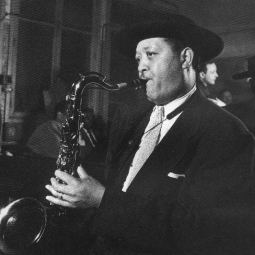Ah, Lester Young…one of the greatest improvisers in all of jazz. He helped open the door to what we call the “modern jazz” period by virtue of his more linear, spatially melodic approach to improvisation. Jazz saxophonists from Charlie Parker, to Stan Getz, to Lee Konitz, to Jimmy Giuffre, to Joe Henderson, to Mark Turner demonstrate a clear connection to his lineage.
When people describe Lester’s playing, they use words like “relaxed”, “floating”, “spacious”, “lyrical”, “light”. My friend, the poet and jazz writer Mark Weber, calls him “the master of time and space”. I couldn’t agree more.
He never seemed to be in a hurry whenever he played, no matter how fast the tempo. It was like we always waiting patiently for the muse to speak to him, to guide him forth.
So it should come as no surprise that all this was reflected in his physical gesture as he played. Click on this link to watch this performance from 1950:
Lester is the picture of calm and dynamic stillness. His head is balanced on top of his spine, his shoulders, arms and back are wide and relaxed. He is sitting in easy, upright balance. Even his fingers seem to move ever so softly and lightly. He’s tapping his feet in time, but doing it with no strain. Sort of like dancing with the music.
And of course his solo is lovely. Even though this is from the period in his playing career that jazz critics consider to be outside of his “best years” as a performer, he is still swinging magnificently. Still floating with the time. Still moving lightly. Still waiting for it, instead of pushing it.
I can’t help but make the connection between his aesthetic approach and his bodily gesture.
This was the first video footage of Lester Young I’d ever seen. As he plays, he looks much like I’d imagined he would. No strain. No pulling himself out of balance. No jerky “expressive” gestures. Nothing unnecessary. He never wasted a single note when he improvised. He doesn’t seem to waste an ounce of energy as he plays. No big surprise that his time feel is always so wonderful.
Have you ever seen a performance where you get distracted (or even annoyed) by all the tense and unnecessary flailing that the performers bring to the music? So have I. It makes me wonder: Are they doing all this because they are freely expressing themselves as they play, or are they actually imprisoning themselves by their own habits of tension?
I know in my own experience that the more I “wait for it” the way Lester Young seems to, the more expansive and even surprising (to me, anyhow!) my creative expression becomes. My sense of time and rhythm deepens. My melodic instincts come to life. Stillness in gesture. Openness to the muse. No matter the tempo, dynamics, or complexity.
Much of this “waiting for it” is expressed in my own bodily gesture. I allow myself to stay free and balanced, calmly alert. I avoid tensing my neck and shoulder. I don’t push my pelvis forward. I don’t lock my knees. I don’t gasp in air loudly. Everything stays easy.
So notice yourself as you play. Do you have a completely different set of gestures as you perform compared to when you practice? Do you strain and flail as you pull yourself out of easy balance? Do you feel like you can’t find intensity without first creating tension in yourself?
If you answered yes to any of these questions, I invite you to see what it’s like when you leave yourself alone as you play. Much like Lester Young, you might find that intensity and excitement can be created and maintained with so little effort.


